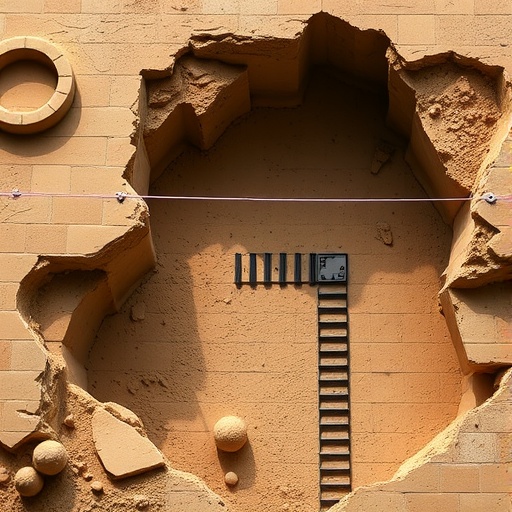In the ever-evolving field of archaeology, the integration of centuries-old discoveries with modern research techniques has remained a daunting and time-consuming challenge. Researchers often wrestle with the task of connecting new findings with the vast troves of information contained in decades of archaeological catalogues and publications. This sophisticated conundrum has found a groundbreaking solution in the form of AutArch, an innovative software that harnesses the power of artificial intelligence to revolutionize data extraction and interpretation in archaeology.
AutArch represents a significant technological leap forward, utilizing advanced neural networks that have been meticulously trained to autonomously detect, analyze, and relate common archaeological “objects” that appear in diverse archives and catalogues. These objects range from grave drawings and human skeletal remains to pottery fragments and stone tools. By automating the process of data extraction, AutArch effectively bridges the gap between manual labor-intensive research methods and the potential for rapid, large-scale data analysis, which until now was largely impractical.
At the heart of AutArch’s capabilities lies its ability to interpret complex visual data within archaeological documentation. One striking example is its proficiency in analyzing grave drawings. The software can identify critical elements such as orientation arrows indicating the cardinal directions and scales embedded within these images. This allows AutArch not only to pinpoint the location of an artifact within the image but also to calculate its precise dimensions and spatial orientation. This level of automatic detail extraction directly enhances researchers’ capability to compare and contrast archaeological findings with a new level of accuracy.
This breakthrough was spearheaded by Dr. Maxime Brami, a leading archaeologist at Johannes Gutenberg University Mainz, who emphasizes that AutArch’s automatic interpretation capabilities are a fundamental game-changer. The software’s ability to extract spatial and dimensional data from centuries-old documents without human intervention drastically reduces the time spent on tedious tasks such as resizing, reorienting, or reformatting images—processes that traditionally consumed hundreds or thousands of hours in archaeological studies.
Kevin Klein, the software developer and lead author on the AutArch study, elaborates that beyond simple automation, the software’s design philosophy prioritizes transparency and user control. Unlike other AI systems that often operate as inscrutable “black boxes,” AutArch incorporates a user-friendly interface that enables researchers to review, verify, and adjust the data extracted by the algorithms. This ensures that while the process is automated, human expertise remains central, maintaining scientific rigor and accountability.
The scope of AutArch’s utility extends far beyond mere object detection. It also has profound implications for interdisciplinary work within the digital humanities. Antoine Muller, a Palaeolithic researcher involved in the study, highlights that the software’s methodology is flexible enough to be applied across virtually any archaeological material. As long as an artifact’s shape, size, or orientation has interpretive value in terms of its technological, functional, or chronological context, AutArch can be adapted to analyze it. This scalability empowers researchers to confront the ever-increasing volumes of archaeological data with unprecedented agility.
One illustrative application of the software’s analytical power concerns the study of burial orientations from the third millennium BCE in Central Europe. AutArch was used to analyze over a hundred Corded Ware graves alongside sixty-six Bell Beaker graves excavated from the Czech Republic. It successfully parsed the skeletal orientations encoded in drawings and extracted meaningful patterns showing that men and women were traditionally buried facing opposite directions—a subtle yet critical cultural indicator that was arduous to quantify manually.
This ability to harness historical visual records for detailed archaeological insights conveys the transformative potential AutArch holds for the discipline. By integrating data from ancient publications with digital artifacts, such as 3D scans held in museums, researchers can now create comprehensive databases that marry old and new sources. This integration helps unlock patterns that have long remained obscured due to the sheer complexity and volume of data.
The development of AutArch was an intrinsically interdisciplinary endeavor involving computer scientists and archaeologists from a broad network across Europe. Ralf Lämmel, a computer scientist from Koblenz University, led the machine learning and statistical validation efforts that underpin the software’s robust performance. This collaboration ensured that both archaeological expertise and computational sophistication were woven seamlessly into the fabric of the project.
Funded under the auspices of the German Research Foundation’s COMOVE Project and the European Research Council’s YMPACT Project, AutArch benefits from significant institutional recognition. Its open-source nature, with the software freely accessible on platforms such as Zenodo and GitHub, promises to democratize access to advanced archaeological research tools and enable collaborative enhancements by the global research community.
By automating the extraction and synthesis of data from archaeological catalogues, AutArch confronts one of the most persistent bottlenecks in historical research: the laborious manual interpretation of images and drawings. This innovation accelerates the pace at which historical questions can be addressed, freeing researchers to pursue more complex interpretive work where human insight is irreplaceable. It represents a rare convergence of cutting-edge artificial intelligence with the enduring quest to uncover humanity’s past.
As the archaeological record continues to grow exponentially through both excavation and digitization, tools like AutArch will become indispensable. They help transform raw visual data scattered across myriad publications into structured, analyzable information—thereby creating new opportunities for discovery and cross-disciplinary scholarship within digital humanities and beyond. In this sense, AutArch does not merely serve archaeology; it points toward the future of how we will collectively manage and make sense of cultural heritage data in an increasingly data-rich world.
The success of AutArch signals a paradigm shift in archaeological research methodologies, one marked by a harmonious union of AI’s computational strengths and human interpretive expertise. The continued development and adoption of such tools will undoubtedly catalyze a deeper and more holistic understanding of the past, ensuring that ancient knowledge is not lost but dynamically integrated into future discoveries.
Subject of Research: Not applicable
Article Title: An AI-assisted workflow for object detection and data collection from archaeological catalogues
News Publication Date: 2-Jun-2025
Web References: https://doi.org/10.1016/j.jas.2025.106244
References: Klein et al. 2025
Image Credits: Klein et al. 2025




